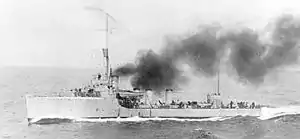HSwMS Wachtmeister (10)
HSwMS Wachtmeister (10), later (26), was a destroyer of the Swedish Navy during World War I, built at Lindholm Shipyard in Gothenburg, and was launched on December 19, 1917, as the second of two destroyers of the Wrangel class.[1] The ship class was among the most modern destroyers in the world just after the end of World War I. At the outbreak of World War II in 1939 she was stationed as part of the Gothenburg Squadron. Wachtmeister was decommissioned in 1947 and was subsequently sold for scrap in 1950. The ship was named after the Swedish noble family Wachtmeister.
 | |
| History | |
|---|---|
| Name: | Wachtmeister |
| Namesake: | Wachtmeister noble family |
| Builder: | Lindholmens |
| Launched: | 19 December 1917 |
| Completed: | 19 October 1918 |
| Out of service: | 13 June 1947 |
| General characteristics | |
| Class and type: | Wrangel-class destroyer |
| Displacement: | 465 long tons (472 t) |
| Length: | 233 ft (71 m) |
| Beam: | 22 ft (6.7 m) |
| Draught: | 9 ft (2.7 m) |
| Propulsion: | Steam geared turbines, 11,000 shp (8,203 kW), 2 screws |
| Speed: | 34 knots (39 mph; 63 km/h) |
| Complement: | 81 |
| Armament: |
|
Design
Wachtmeister's hull was made of nitrated steel. Like former Swedish destroyers, the ship had no proper superstructure on the bow, but had only a protective skirt wall for the command bridge, though there was a small superstructure on the stern. The propulsion machinery consisted of four steam boilers which delivered steam to two steam turbines. The machine generated an output of 11,500 horsepower, giving a maximum speed of 34 knots. Each boiler had a separate funnel, which led to the common four stack arrangement of the time. The two steam turbines were of a new type with reduction gears, which meant that the turbine speed could be shifted down to lower the propeller speed, giving the machinery a better efficiency.[2]
On delivery, the ship's main artillery consisted of two 7.5 cm guns m/12 that were placed on the front and rear deck. The close-range protection consisted of two 6.5 mm machine guns m/14 that were placed on either side of the command bridge. The torpedo armament consisted of six 45.7 cm torpedo tubes m/14. Four of these stood as in the previous class in two double stands on the main deck. What was new was that two more were placed behind gaps in the front of the hull.
History
Wachtmeister was built at Lindholm's Gothenburg shipyard and was launched on December 19, 1917. After fitting out and trials she was delivered to the Swedish Navy on October 19, 1918.
During an exercise on the evening of June 8, 1922, Wachtmeister was rammed just ahead of the bridge by the destroyer HSwMS Vidar. Three people who were in Vidar's forebody were seriously injured, one later died during transport to the hospital. Wachtmeister got a 20-meter long imprint of the hull and three people were thrown into the water, there could soon be rescued. Vidar was towed into Bergkvara while Wachtmeister could reach Karlskrona by herself. Both destroyers were repaired and taken into service the following year.[3]
In 1923, Crown Prince Gustav Adolf would be engaged to Louise Mountbatten with the engagement taking place in England. On 28 June, Wachtmeister went from Karlskrona together with her sister ship Wrangel and all three ships in the Sverige class. On July 2 they went to Sheerness, England where the couple visited the ships. A couple of days later, the journey proceeded to Rosyth, Scotland, where they visited the English Atlantic fleet before going back to Sweden.[4][5]
In the mid-1920s, the ship's boilers, which were initially coal-fired, were converted to oil-fired.[1]
World War II
In 1939, the ship was redeployed, when the forward two torpedo tubes were removed and a 25 mm anti-aircraft automatic gun was added. Furthermore, the two machine guns were replaced with an 8 mm anti-aircraft machine gun m/36 that was mounted on the aft bridge and two depth charge positions with 16 depth charges m/24.[1] During the beginning of World War II, Wachtmeister together with her sister ship was part of the Gothenburg Squadron.[6] In the winter of 1940-1941, the ship would receive new boilers,[6] but by late autumn 1943, she was put into material reserve in Stockholm.
References
Notes
- Hofsten, Waernberg & Ohlsson 2003, p. 154
- Borgenstam, Insulander & Kaudern 1989, p. 19
- Borgenstam, Insulander & Kaudern 1989, p. 37
- Steckzén 1949, p. 217
- "Långresor och utlandsbesök med svenska örlogsfartyg mellan 1784 - 2005" [Long journeys and international visits with Swedish warships between 1837 - 2005]. www.alvsnabben.se (in Swedish). Älvsnabben. Retrieved 24 October 2017.
- Lagvall 1991
Print
- Borgenstam, Curt; Insulander, Per; Kaudern, Gösta (1989). Jagare: med Svenska flottans jagare under 80 år (in Swedish). Västra Frölunda: Marinlitteratur. ISBN 91-970700-4-1. SELIBR 7792227.CS1 maint: ref=harv (link)
- Hofsten, Gustaf von; Waernberg, Jan; Ohlsson, Curt S. (2003). Örlogsfartyg: svenska maskindrivna fartyg under tretungad flagg. [Forum navales skriftserie, 1650-1837 ; 6] (in Swedish). Stockholm: Svenskt militärhistoriskt bibl. i samarbete med Marinlitteratur. ISBN 91-974384-3-X. SELIBR 8873330.CS1 maint: ref=harv (link)
- Lagvall, Bertil (1991). Flottans neutralitetsvakt 1939-1945: krönika. Marinlitteraturföreningen, 0348-2405 ; 71 (in Swedish). Stockholm: Marinlitteraturfören. ISBN 91-85944-05-X. SELIBR 7753511.CS1 maint: ref=harv (link)
- Steckzén, Birger, ed. (1949). Klart skepp: en bok om Sverigeskeppen Sverige, Gustaf V, Drottning Victoria (in Swedish). Stockholm: Norstedt. SELIBR 1417624.CS1 maint: ref=harv (link)